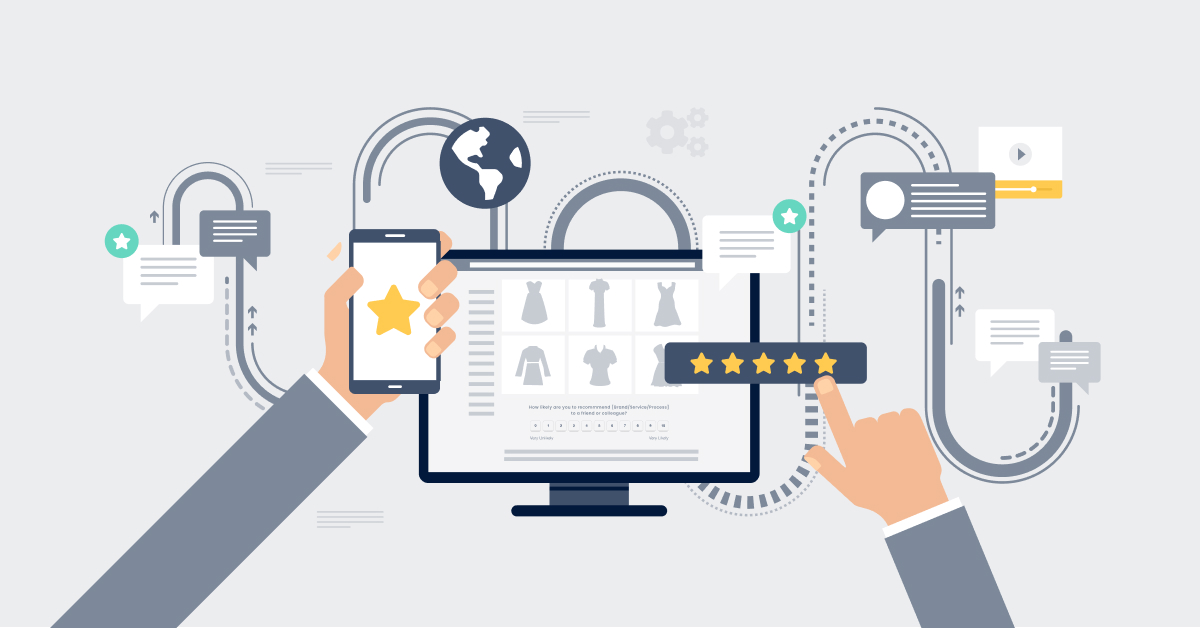
3… 2… 1… – it’s mine! The digital age allows customers to purchase their heart’s desire in just a few clicks. Thanks to the unlimited knowledge available on the Internet, we can be better informed than ever. Our purchasing behavior has changed considerably in recent years due to ever-evolving technology. Digital change has made it possible for customers to get more and more information and reviews about specific services and articles, allowing them to quickly form their own opinion. Advertising and marketing alone often do not lead to purchase, because the customer now wants to find out in detail about the customer satisfaction and experiences of others via evaluation portals, which usually has a direct impact on consumer purchasing behavior.
Bad Reputations Spread Quickly on the Internet
Poor service and bad products – in the worst case, negative reviews can quickly generate big losses for companies. Interested parties googling a product or company usually get immediately confronted with the reviews of other consumers.
A negative experience during the information acquisition process can lead to the customer ultimately opting out of buying a product. Therefore, it is important to closely understand the customer journey of potential customers and avert such dangers. What exactly moves consumers? What ultimately leads to the purchase decision? Why was the purchase not completed? Companies that address such issues and accurately analyze their customers’ journeys are a big step ahead of their competitors.
What Does Customer Journey Mean?
The term „customer journey“ refers to the individual phases that the customer goes through before selecting a product or item and completing a purchase. However, the customer journey has changed considerably in recent years due to accelerated digitalization. For example, while consumers used to see advertisements and then went straight to the store to buy the goods, nowadays the customer usually does not immediately decide on which product they ultimately buy. The customer comes into contact with the company or the brand several times via various channels and informs himself thoroughly and independently about the products and services. These points of interaction, also known as touchpoints, encompass all the moments when a customer comes into contact with a brand or service. A further distinction can be made between direct and indirect customer touchpoints.
Direct Touchpoints can usually be directly controlled and influenced by the advertiser, i.e. the company. By running ads on social media channels, such as Facebook and Instagram, or in the form of television commercials, companies can provide targeted information.
Indirect Touchpoints Indirect touchpoints are, for example, user forums or evaluation portals where customers can find out about products. Experience reports and opinions are exchanged here, and companies often can not exert a direct influence.
In addition, however, a distinction must also be made between the format and the channel. For example, a blog post or ad on Facebook is a format, while Facebook or a web page represents the respective channels.
The Customer Journey – More Than a Wild Ride
As with any good and varied trip, the purchaser goes through several different phases during a customer journey. These can be seen as an extension of the well-known AIDA model.
- Awareness
This raises awareness of a product. The customer recognizes his need or problem and becomes aware of suitable products and solutions. This is done, for example, by viewing an ad on TV or via the information on the Internet. - Favorability
The customer’s interest is intensified by renewed contact with the company and the product. - Consideration
After reconsideration, the customer thinks about buying the product or using the service. He ponders how well the product or service will satisfy his current need, for example. In this phase, customers often use evaluation portals, reading other people’s testimonials in order to make informed opinions about the suitability of the offer. - Conversion
The customer buys and uses the product. Either the purchase is completed online or directly in a brick-and-mortar retail store. - Retention
The ultimate discipline of the customer journey: after extensive examination and use of an item or service, the customer is enthusiastic and, if possible, completes a purchase again. - Advocacy
The customer is so enthusiastic that he recommends the product to his family, friends and colleagues. The customer may even write Amazon reviews himself or publish an experience report in review portals.
Understanding the Customer Journey – an Example
Depending on the product or service, the customer goes through the different phases of the customer journey in differing intensities. To illustrate the process a little better, let’s look at it again with the help of an example.
The customer has long been dissatisfied with his current coffee machine, but since it still works, has not yet bought a new one. But whilst watching TV, his attention is attracted to a new model from the Coffeelicious brand. In the ad, he notices that this coffee machine meets his needs exactly and offers much more functions than his old one (Awareness).
Through further ads and good marketing, the customer also becomes aware of the product through other channels such as Facebook or in print. He comes into more contact with the Coffeelicious brand and develops sympathy with it (Favorability).
However, as this is a costly investment, he would like to consider the purchase decision. He clicks through different portals and reads a variety of customer reviews about the product. By chance, he learns that an acquaintance recently bought a coffee machine from Coffeelicious. This educates him about other important information about service and customer satisfaction (Consideration).
After extensive research, the customer finally decides to make a purchase. Since he is currently in the city, he decides to buy the coffee machine from the specialist retailer of his trust (Conversion).
Although after purchase, the customer does not need another new coffee machine, he remains loyal to the brand and regularly equips himself with coffee pods and other kitchen items in the range (Retention).
As a happy and satisfied customer, he tells his friends and acquaintances about his new acquisition and speaks in the best tones of Coffeelicious and the products of the brand (Advocacy).
Good Things Come to Those Who Wait?
The customer journey process can take anywhere from a few minutes, hours, weeks, to several months, depending on the product or service. It depends entirely on the state of mind and the type of item that is available for purchase. For example, the customer journey when buying a car is usually much longer than with cheaper products such as a toothbrush.
The more expensive a product or service is, the more time passes due to intensive consumer considerations. The path a customer travels during this time can be recorded using a Customer Journey Map.
What is Customer Journey Mapping?
In the course of Customer Journey Mapping, formats, channels, touchpoints, and other factors are mapped to the various phases of the customer journey to help visualize it. It, therefore, includes all aspects that lead to higher customer satisfaction. Such a map makes it possible to track and describe the customer experience. This allows the processes to be viewed from the customer’s point of view and to close the “reality gap” between companies and customers. Another goal is to filter out the so-called “moments-of-truth”. These are the touchpoints where companies can most sustainably influence the customer and deliver the highest possible performance.
If this method is used correctly, companies can optimally and harmoniously adapt their own service portfolio to the needs of their customers.
Is Customer Satisfaction Measurable? Analysis of the Customer Journey
Offline, it is usually difficult to track the customer journey of customers. After all, it’s almost impossible to directly understand how many times a customer has been in touch with a print ad, how they’ve learned about a product, what experience they’ve received from friends, and what ultimately led to their purchase decision. This, on the other hand, is much easier online. With a well-developed Net Promoter System® businesses can easily get data and feedback on customer satisfaction. However, a detailed customer journey analysis also requires exact data storage about the customer’s behavior in order to be able to guarantee a valid survey.
Measuring Customer Loyalty with NPS
Thanks to NPS, a rating scale from 0 to 10 and a suitable question enable you to evaluate customer satisfaction and thus obtain valuable information. Customers usually respond spontaneously and intuitively to these questions, which makes it possible to present a realistic picture of satisfaction.
How is the Net Promoter Score® calculated?
The respective Net Promoter Score is determined by a simple calculation. It shows whether the customers would recommend the respective services or items. The well-known measure of customer satisfaction is therefore due to the ratio of critics (detractors) and enthusiastic customers (promoters). The percentage of detractors is then subtracted from the proportion of promoters to obtain a Net Promoter Score. However, the score alone does not yet indicate where problem areas are located. It is therefore very important to evaluate both the quantitative and the qualitative data and to analyze them appropriately. Relying on proper feedback management, it is important not to underestimate the potential of detractors and to analyze both types of customers.
Thanks to efficient platforms such as zenloop, companies can generate useful customer feedback through tailor-made surveys. zenloop scores well here thanks to short survey times and high response rates. This enables companies to identify potential for improvement within their customer journey and to effectively implement them. The Net Promoter Score helps to identify critics and ideally, help you convert them into loyal customers.
Improving the Customer Journey and Expanding it in a Customer-oriented Way
A customer journey should be designed to generate full customer satisfaction. It is essential to fully understand the needs of consumers and to recognize customer behavior patterns and motives. If detailed data analysis helps you to follow an ideal customer journey, there can be huge optimization potential by using the knowledge gained.
Which Customer Touchpoint Was Responsible for a Purchase?
Ultimately a thorough analysis should reveal which touchpoints on the customer journey were decisive for the customer’s decision against a product or service, and where the user experience needs improvement. As a result, communication should be made more efficient and market processing tools should be geared to the needs of customers. By optimizing this, the conversion rate can be significantly improved. The goal is to pick up the customer at the various touchpoints during their customer journey and to support them with their current questions. A good way to improve the customer journey, for example, is with tailor-made services and the provision of optimal customer service (service hotline, etc.).
Delivering the Right Information at the Right Time
The customer journey analysis offers the opportunity to track customers’ journeys from start to finish and to examine how the consumer experiences the company or brand. The goal is to make the customer’s experience as positive as possible. The findings reveal unrealized potential and enable marketing measures to be prioritized. This makes it very easy to define the really decisive clicks and give the customer a good feeling. However, analysis alone is not enough. Digitization is causing the number of touchpoints between the customer and the brand to explode. In this way, new “desire paths” are constantly developing, which can distract the customer from his actual path and thus make his journey even more versatile. The customer journey is rarely a straightforward one – so it’s always the right time to put yourself in their shoes.
Tags: Customer Experience






